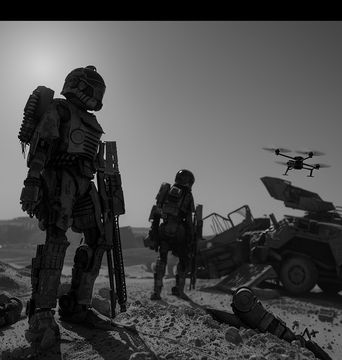U.S. MILITARY GEARS UP FOR ROBOT SOLDIERS: MACHINES TO TAKE OVER FRONTLINE IN FUTURE WARS

From the beaches of the D-Day landings to the bone-dry deserts of Iraq, soldiers have long been our heroes on the front lines. Positioned in the thick of the action, these brave individuals risk their lives to protect our freedoms. But the front lines are changing, becoming less a place for human heroism and more a strategic front for military technologies. The U.S. Army has plans to draft robots and drones into the rigours of front-line combat, exploiting their advantage to execute dangerous tasks in efforts to minimize human casualties.
This synthetic substitution was exemplified in a seminal exercise called Project Convergence, where robots, under the harsh scrutiny of simulated combat scenarios, faced a litany of trials and challenges. While live ammunition was withheld from the trials, these fledgling soldiers-of-steel had a tough time dealing with peripheral vision issues.
As they navigate these technical roadblocks, it is clear that Army leaders see the value in bridging the gap between bulk military force and guerrilla responses. The goal is for almost every U.S. Army unit, right down to the smallest foot patrols, to employ these unmanned aerial vehicles in the near future.
Critics have voiced their concern over the military's zealous drive towards automation, however. It remains to be seen how these robotic conscripts will adapt to difficult terrains or extreme weather conditions. There are also fears that skillful snipers could dismantle these robotic soldiers by targeting their sensor arrays.
But the U.S. military is steadfast in its goal: a future where humans to robots ratio of about 2-to-1 or 3-to-1 underscores a strategy to achieve technological dominance over potential adversaries. It's clear that the context of this goal is a rapidly evolving global arms race, with countries like China and Russia already heavily investing in their military AI and robotics development programs.
Against this backdrop, the Army has made hard decisions, shelving some traditional aircraft programs to channel their resources into developing cheap, off-the-shelf drones. While some high-tech systems have been costly and fallen foul to vulnerabilities, the strategic vision now revolves around creating a low-cost drone capable of bringing down an enemy's multi-million dollar aircraft.
However, as we tread closer to a reality of automated soldiers, a boatload of ethical and tactical questions arises. At the forefront of this debate is the question of autonomy. There is ongoing concern—echoed by the United Nations—about the possibility of fully autonomous robots operating in combat scenarios without direct human oversight. Interlinked is the fear of enemy forces gaining control of U.S. robots.
The labyrinthine path to integrating robots and drones on the front lines is far from smooth, but if the vision of these Pentagon planners becomes a reality, these cybernetic soldiers could forever change the face of warfare. We need to navigate the maze of ethics, safety, and regulations very cautiously before we usher in this new era of artificially intelligent combatants.